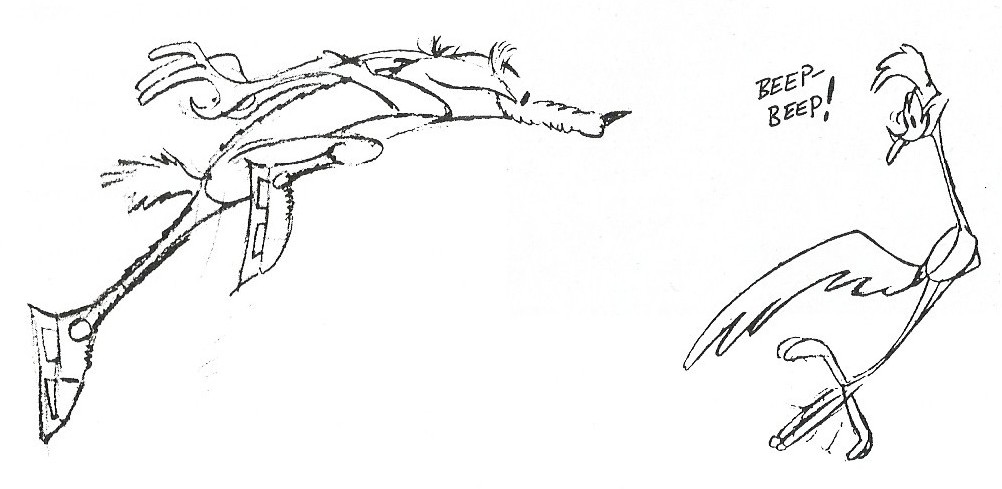The ACME of Animation
Go into your local video sell-through store, bypass the feature film section, wander past the music videos and you’ll eventually arrive at the children’s section. Without a doubt you’ll be able to track down several tapes of classic Warner Bros. animation – Bugs Bunny, Daffy Duck, Sylvester & Tweetypie, Elmer Fudd, Pepe Le Pew and maybe even the odd Speedy Gonzales. Notice any missing names? Yep. You will hunt in vain for any Wile E. Coyote (aka Famishius Vulgarius Ingeniusi) and Roadrunner (Birdius High-Ballius) cartoons. It’s difficult to see why they’ve been so ignored as for me they represent a distillation of all that is entertaining about animation, impossible to recreate as a live-action film.
The first cartoon ‘Fast and Furry-ous’ appeared in 1949. The series was originally conceived as a satire on the chase cartoons which were highly popular at the time, but nobody saw it that way, they were all too busy laughing at the chase sequences. The series continued for the next fifteen years under the guiding hand of Chuck Jones, culminating in an Academy Award nomination in 1961 for ‘Beep Prepared’ – other directors have since tried their hand at making the films, but just as Fred Quimby must be considered the essence of Tom & Jerry, so Chuck Jones is to Wile E. Coyote (Evereadius Eatibus) and Roadrunner (Digoutius Hot-Rodius).
Their appeal, to some extent, lies in the way they produced an infinite number of variations on the chase theme, a great many of which produced the same result; Wile E. falling down a canyon, accompanied by a whistling sound and with an expression on his face that says “Oh No, here we go again!” far better than any words. The tension is generated in a classic, almost Hitchcockian style – you tend to know exactly what is going to happen, you are just totally unsure how, or indeed when. An example: the Coyote is standing on an overhang, trying to reach the Roadrunner who is on the other side of a canyon. He sets up a see-saw and staggers onto it carrying a boulder, which he throws in the air. What happens next?

- a) It lands on his head?
- b) It propels him vertically upwards onto the bottom of another overhang above – he then drops down onto the see-saw, the boulder goes back up and then lands on his head
- c) It propels him horizontally across the canyon into the opposite wall, just below the Roadrunner, from where he falls down into the canyon.
- d) The boulder lands on the other end of the see-saw, doesn’t move it at all and rolls down on top of him.
The correct answer, in fact, is e) The boulder lands on the other end, tipping the see-saw alright, then continues down through the overhang, leaving a nice hole – the Coyote slides down the see-saw and into the hole, cue Wile E. falling down a canyon, etc. Give yourself a point nonetheless; the other answers are almost correct as I’ve seen all of them, and several more besides, happen in various Chuck Jones cartoons.
One of the hallmarks of the series was the appearance of objects made by that well-known company called Acme; we have the Acme Giant Rubber Band (For Tripping Roadrunners), Acme Tornado Seeds, an Acme Rocket, etc. About the only thing these have in common is a tendency not to fulfill their specification, tho’ to be fair, this is often at least PARTLY due to misuse by the client! The name ‘Acme’, incidentally, used to be chosen by companies because it put them near the start of the Yellow Pages, back in the days before AAAAAAB Taxis.
- This reliance on Acme products is enshrined in Chuck Jones’ Rules; these are taken from his book ‘Chuck Amuck’ (Farrar Strauss Giroux, New York), a part-autobiography, part-textbook on how to make animated cartoons. As he says, “there are – there must be – rules. Without them, comedy slops over at the edges. Identity is lost”. Here are the rules in full:
- The Roadrunner cannot harm the coyote except by going “Beep-beep!”.
- No outside force can harm the Coyote – only his own ineptitude or the failure of the Acme products.
- The Coyote could stop anytime – if he were not a fanatic (Repeat: “A fanatic is one who redoubles his effort when he has forgotten his aim” – George Santayana).
- No dialogue ever, except “Beep-beep!”.
- The Roadrunner must stay on the road – otherwise, logically, he would not be the Roadrunner.
- All action must be confined to the natural environment of the two characters – the Southwest American desert.
- All materials, tools, weapons or mechanical conveniences must be obtained from the Acme corporation.
- Whenever possible, make gravity the Coyote’s greatest enemy.
- The Coyote is always more humiliated than harmed by his failures.

